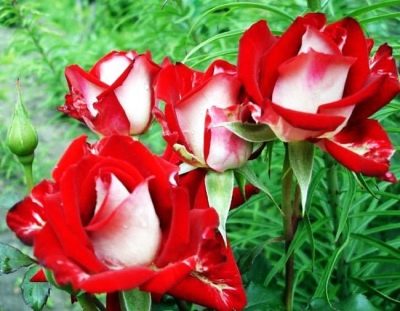
- Name synonyms: Rose Alliance
- Breeding year: 2002
- Group: tea-hybrid
- The main color of the flower: red
- Diameter, cm: 6-8
- Description of the bush: medium height, straight, branched
- Bush height, cm: 100-120
- Flowering period: from the first ten days of June to 2-3 ten days of October
- Appointment: for cutting, for hedges, arches, gazebos, for single plantings, for group plantings, for mixborders, for growing in flower beds
- Leaf color: dark green, glossy
Among the many varieties of roses, species characterized by the versatility of decorative use are in high demand. A striking representative of this category is the Alliance rose, which stands out for its many characteristic features.
Breeding history of the variety
Rose Alliance is the brainchild of Japanese breeders, which emerged from the Keisei Rose Nursery greenhouses. The variety was bred in 2002. The flower belongs to the hybrid tea group. The Central region of Russia is the most comfortable for flower growth. Good climatic conditions for growing Alliance roses are also in Ukraine.
Description of the variety
Rose Alliance is an erect bush endowed with moderate branching, growing in height up to 100-120 cm.The diameter of the flower shrub reaches 70 cm.The plant is characterized by good foliage, dark green leaves with pronounced gloss, strong stems that do not need support, thin shoots, as well as a deep, branched root system. There are few thorns on the stems. A distinctive feature of the flowering shrub is its rapid growth rate.
Advantages and disadvantages
Each flower variety has advantages and disadvantages. Among the advantages of the variety are: good frost resistance, strong immunity, resistance to rain and summer heat, no need to tie the shoots, re-flowering.
Among the disadvantages that the culture has a minimum, one can distinguish not very pronounced aroma of flowers, as well as the fact that during the period of prolonged rains, not all buds open.
Flowering features
The rose is a multi-flowering species. The flowering period is observed from June to mid-October. The shrub blooms profusely. During the flowering period, predominantly single flowers of medium size open up - the diameter of the bud is 6-8 cm. The structure of the flower consists of 20-25 double petals. Attention is drawn to the unusual, two-tone color of the flower - the main tone is red or pomegranate, and the outside is white and silver. The aroma of the rose is light, not cloying.
Use in landscape design
Rose Alliance is ideal for hedges, various group compositions, single plantings in a flower bed, as well as zoning flower meadows. Many summer residents plant a Japanese rose as a decoration for a fruit and berry front garden. In addition, the rose is suitable for cutting. In a vase, flowers can stand for about 2 weeks, delighting with an attractive appearance and light aroma.
Landing
A decorative rose is planted in late April - mid-May, when the temperature has stabilized. For planting, choose a sunny area with pre-prepared soil. The soil should be light, enriched with fertilizers, moisture-absorbing, and breathable. It is important that the substrate is not acidic and waterlogged.In addition, the occurrence of groundwater must be at least 180-200 cm. The site must be leveled, small hills are allowed, where the flowers will be warm, light, sunny. Despite the fact that rose bushes tolerate partial shade, they are comfortable to grow in a sunny environment.
Growing and care
To grow a Japanese rose, you need seedlings that are planted in deep holes (50-60 cm). The distance between landings should be at least half a meter. Before planting, the seedlings are placed in water for 4-6 hours, which contributes to faster plant growth. The plantings are slightly trampled with soil and watered abundantly.
Agrotechnics of the bush consists of the following activities: weekly watering with warm water (15-20 liters under the bush), which stop at the end of summer, regular feeding (before, during and after flowering), timely loosening and weeding, mulching, enriching the soil, sanitary pruning , preventive treatment with fungicides and insecticides, shelter for the winter. In addition, it is imperative to cut withered flowers on the bush.
Watering and feeding
The rose requires maintenance of water balance, therefore it is recommended to water every week. With prolonged drought, you can double the number of waterings. Among the fertilizing that the plant needs, it is worth highlighting nitrogen fertilizers (before flowering), organic and mineral fertilizers during the formation of buds, their blooming, as well as phosphorus and potassium fertilizers - after the bush has faded.
Pruning
The shrub needs periodic pruning. In early spring, frozen shoots and lashes are removed, and the tops are also slightly shortened. In the summer season, the bush is cleaned of inflorescences that have already faded. In late autumn, sanitary pruning is carried out, in which diseased shoots are removed, and bushes are carefully thinned out, which have grown greatly over the summer. Rejuvenating pruning is recommended every 4 years, when all old shoots are completely cut out.
Frost resistance and preparation for winter
Although the plant is quite cold hardy, it needs some protection during the cold season. In late autumn, all shoots are shortened, and before winter the shrub is carefully bent to the ground and covered with a thick layer of peat fertilizers. It is important that the protective peat layer is at least 20-21 cm. This will protect both from severe frosts and gusty cold winds. In the spring, this peat layer is carefully leveled, freeing the plant. In addition, agrofibre can be used as a shelter.
Diseases and pests
This variety has good immunity, which protects the shrub from many fungal diseases. Only untreated plants are susceptible to diseases such as powdery mildew, gray mold and black spot. Sometimes rose planting is attacked by green rose-colored aphids, scale insects, leafworms and spider mites.































































